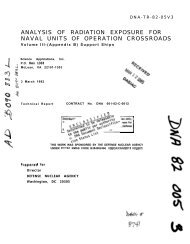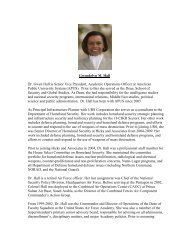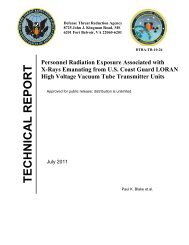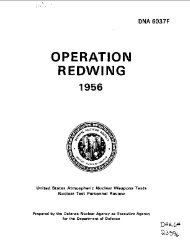Shield - Defense Threat Reduction Agency
Shield - Defense Threat Reduction Agency
Shield - Defense Threat Reduction Agency
Create successful ePaper yourself
Turn your PDF publications into a flip-book with our unique Google optimized e-Paper software.
A LOOK BACK<br />
/ the shield / fall 2011<br />
In July 1946, two atomic devices were exploded near Bikini Atoll as part of Operation<br />
CROSSROADS. This operation, designed to examine the effects of nuclear weapons on naval vessels and<br />
Army equipment, had lasting effects on both the U.S. nuclear program and marked the beginning of the<br />
establishment of radiation safety policies and procedures.<br />
In the months leading up to the operation, the atomic bomb<br />
producing Manhattan Project, along with the rest of the war<br />
industry, was winding down. Like returning soldiers and war<br />
industry workers, many of the project’s scientists returned<br />
to their civilian careers. Those who remained in Los Alamos<br />
struggled to expand the U.S. nuclear arsenal for the first atomic<br />
weapons effects tests, code named CROSSROADS, scheduled<br />
for July 1946 at Bikini Atoll in the central Pacific.<br />
To prepare and plan for CROSSROADS in January 1946<br />
the Joint Chiefs of Staff set up Joint Task Force I (JTF) with<br />
members from the Navy, Army, Army Air Forces, and scientists<br />
from Los Alamos. Under the command of Vice Adm.<br />
William H.P. Blandy, the task force chose the northern extreme<br />
of the Marshall Islands as the proving ground for Shot<br />
ABLE, an altitude detonation, and Shot BAKER, a low water<br />
detonation. The third, Shot CHARLIE, a deep water detonation,<br />
did not receive much attention because it was supposed<br />
to take place the following year, but was canceled.<br />
In March, site preparations in the Pacific began with the<br />
relocation of more than 160 Bikinians to the neighboring<br />
Rongerik Atoll, where the Navy’s Construction Battalions<br />
or “Seabees” had constructed houses and infrastructure for<br />
them. 1 Meanwhile, the Navy sailed more than 90 vessels,<br />
including three captured German and Japanese warships, to<br />
the Atoll and anchored them in the lagoon as a target array.<br />
Also en route was a fleet of 150 support ships to provide quarters<br />
and temporary workstations for the JTF. In Washington,<br />
D.C., the services kept JTF planners busy with requests to<br />
incorporate more data collection experiments into the plan.<br />
As the events of the spring and early summer of 1946 unfolded,<br />
the name for the operation seemed almost prescient. Not<br />
only were military research and development, the structure of<br />
the armed forces, and the national security apparatus in the<br />
United States at a crossroads, but so was America’s role in the<br />
international arena. The U.S. Congress’ inability to pass an<br />
atomic energy bill left the future of nuclear weapons development<br />
hanging in the balance. During this uncertain period,<br />
the Manhattan Engineering District continued to administer<br />
the program as a temporary wartime holdover. Without<br />
legislative guidance, the program’s future, its funding and<br />
whether civilian or military authorities would have custody of<br />
it remained unclear. As a result, the scientists in Los Alamos<br />
continued the wartime practice of handcrafting every compo-<br />
1 In 1948 the U.s. navy moved the Bikinians to its base on Kwajalein and eight<br />
months later resettled them permanently to Kili Island.<br />
Operation:<br />
CROSSROADS<br />
BY Bianka J. adams, Ph.d.<br />
Historian, <strong>Defense</strong> <strong>Threat</strong> <strong>Reduction</strong> <strong>Agency</strong><br />
All photos: DepArtment of <strong>Defense</strong>









